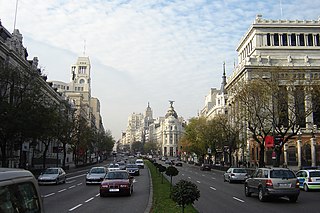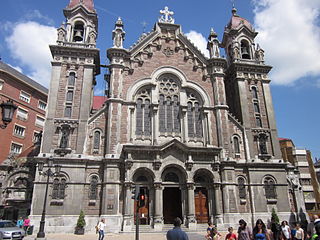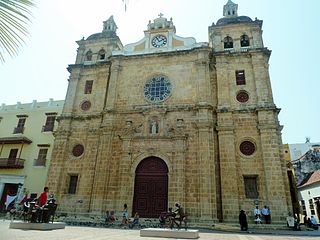
The Churches of Chiloé in Chile's Chiloé Archipelago are a unique architectural phenomenon in the Americas, and one of the most prominent styles of Chilota architecture. Unlike classical Spanish colonial architecture, the churches of Chiloé are made entirely in native timber with extensive use of wood shingles. The churches were built from materials to resist the Chiloé Archipelago's humid and rainy oceanic climate.

Colegio Imperial de Madrid nowadays Instituto San Isidro, was the name of a Jesuit educational institution in Madrid (Spain).
Santa Gadea is a church dedicated to Saint Agatha in Burgos, Spain. The church is famous in history and literature for being the site where Rodrigo Díaz de Vivar at the behest of the Castilian Cortes, forced Alfonso VI to swear an oath that he was not an accomplice in the death of his brother, Sancho while he was besieging Zamora. Es el de la jura de Santa Gadea is the most notable Spanish medieval romance about this event.

The Iglesia de San Lorenzo is a church located in Toledo, Spain. It was built on the site of a mosque dated to the first half of the 11th-century. In 1121 the church is mentioned for the first time, as a Mozarab parish church dedicated to Saint Lawrence. In the 18th-century the San Lorenzo was renovated, expanding it.

Calle de Alcalá is among the longest streets in Madrid. It starts at the Puerta del Sol and goes on for 10.5 km, to the northeastern outskirts of the city. Henry David Inglis described it in 1837 as "long, of superb width, and flanked by a splendid range of unequal buildings".

The church of San Isidro el Real, also known as the Colegiata or Collegiate Church of San Isidore, is a Baroque church in the centre of Madrid, Spain. It is named after and holds the remains of the patron saint of Madrid, Isidore the Laborer, and his wife Santa María de la Cabeza. It has held the status of a Basilica church for centuries.

The Church of Saint Cajetan, known as the church of San Millán y San Cayetano is a Baroque church in Madrid, Spain.

The Church of Our Lady of Montserrat is a Baroque-style, Roman Catholic church located on Calle San Bernardo in central Madrid, Spain.

Iglesia de San Juan el Real is a church in Oviedo, Asturias, Spain. It was established in 1912. Francisco Franco was married in the church in 1923.

Iglesia de San Pedro is the Spanish name for Saint Peter Church located in Lima, Peru. The church was completed in 1638.

The Church of San Francisco, located on one side of the Plaza de Armas of Castro, Chile, is the main Catholic church of Chiloé’s capital. It has a surface area of 1,404 m2, a width of 52m and a height of 27m. The dome above the church's presbytery is 32m high and the height of its towers is 42m. The church is also known as the Iglesia Apóstol Santiago and erroneously as the “cathedral”, which is actually to be found in Ancud, headquarters of the diocese of the same name. The Church of San Francisco does however lead one of the 24 parishes that form this diocese.

Jaime Marquet was a French architect who worked extensively in Bourbon Spain, and whose most important work includes the central plaza of Madrid known as Puerta del Sol and the adjacent monumental building, the Real Casa de Correos or Royal Mail Headquarters, now the offices of the President of the Community of Madrid.

Iglesia de San Gil Abad is a church in Burgos, Spain. It dates to the 14th-15th century. It was declared a Bien de Interés Cultural site by decree of 3 June 1931.

Iglesia de Santa María la Real y Antigua de Gamonal is a church in Burgos, Spain. The Gothic structure dates to the 14th century, although there is evidence of an earlier church dating back to the eleventh century, when King Alfonso VI moved his seat from the destroyed city of Oca of the Auca diocese in 1075. It became a Bien de Interés Cultural listed building on 3 June 1931.

Iglesia de La Merced is a church in Burgos, Spain. Built in the Gothic style from 1498 onwards under architect D. Pedro del Barrio Riaño, it is still used as a parish church of the Jesuits, while the old convent buildings – inhabited by Mercedarian friars for more than three centuries – have now been integrated into a catering business.

The Iglesia de San Miguel el Alto is a Mudéjar church located in Toledo. It is one of the old Latin parishes of the city of Toledo. Apparently, this church was in relation to the Knights Templar being founded by them, serving as chapel or oratory of the inn for the knights of this order.

The Iglesia de San Ildefonso is a Baroque style church located in the center of the historic city of Toledo, in Castile-La Mancha, Spain. It is also known as the Jesuit church and is consecrated to Saint Ildefonso of Toledo, patron of the city and Father of the Church.

The Iglesia de San Pedro Claver is a church located in Cartagena de Indias, in Colombia. This church and its convent are located in the Plaza de San Pedro Claver.

Saint Ildefonsus is a 1609 painting by El Greco. It and his Saint Peter were both painted for the Iglesia de San Vicente, Toledo. It has also previously been misidentified as Pope Eugene I or saint Blaise. It is now in the Real Monasterio de San Lorenzo de El Escorial.





















